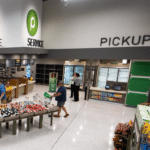
Like drive-through liquor stores, or hairstylists who make house calls, just because a service exists doesn’t mean most people are going to take advantage of it. That seems to be the case with online grocery shopping, as yet another survey shows that, despite predictions to the contrary, the vast majority of us prefer to do our grocery shopping the old-fashioned way – walking up and down the aisles of a physical grocery store.
That’s even though some proponents counterintuitively claim that buying groceries online can actually save you money – more than $750 a year, according to one online grocery fan.
Gallup is out with the results of a new survey in which it asked shoppers about their grocery shopping habits. It found that 11% of Americans say they order groceries online at least once a month – but 81% say they never do.
Even more troubling for retailers who’ve poured millions into ramping up their online grocery capabilities, those numbers are essentially unchanged from the last time Gallup conducted a survey on the subject two years ago.
With more stores now offering grocery delivery, drive-up services or order-online-pick-up-in-store capabilities, it’s a lot easier to order your groceries online today than it was two years ago. But that apparently hasn’t convinced more of us to do it.
“The slow adoption of online food ordering could indicate that people enjoy picking their own groceries in person,” Gallup surmised, “or that they don’t see sufficient savings of time or money to justify the switch.”
Many grocery delivery services make it difficult, if not impossible, to use coupons or take advantage of some of the sales and promotions offered in store. And delivery charges can add up, too.
So how can buying groceries online actually save you money?
After switching to online-only grocery shopping, “I recently did the math, and found that my family saves more than $750 a month,” Business Insider contributor Chelsee Lowe wrote in a recent article, coincidentally published just a couple of days after Gallup released its report.
Lowe estimates that she saves about $12 a month on gas by not driving to the grocery store. She saves about $100 a month by not making impulse purchases in the store. And she estimates the greatest source of savings is her time. “One hour of my time is worth $80,” she reasons, so the two hours a week she doesn’t spend grocery shopping “saves” her $640 a month.
That’s one way to look at it. There are also delivery and membership fees to consider, and the money she’s not saving by not getting the best deals on the products she buys. But Gallup found that online grocery shopping is more common among parents and upper-income adults, so it concludes that those who order groceries online are doing so out of convenience and don’t actually mind paying extra for it.
Amazon’s 2017 purchase of Whole Foods Market seemed to spook the entire grocery industry into getting serious about offering online grocery services, before Amazon put them out of business. But “one could argue that the internet giant hasn’t yet figured out how to take full advantage of its grocery asset,” Gallup said, noting that “it doesn’t appear the purchase has transformed the grocery industry as some predicted.”
But the fact that people like Lowe already swear by it, means that online grocery shopping is something that at least some shoppers want. So Gallup says there’s a “huge opportunity” for someone to figure out how to make online grocery shopping more popular, and more profitable.
“The internet has transformed the way people work, communicate and buy many of the products they use, but buying groceries is not yet one of them,” Gallup concludes. “For now, logistical and cost challenges have helped keep Americans tethered to their standard practice: going to the local store to get their food.”
So until you can really, truly save $750 a month by buying your groceries online – and not just by doing some creative accounting and putting a dollar figure on your time – it seems most of us will stick with getting our groceries in person. And if someone cracks the code in the meantime, and figures out how to make online grocery shopping the new normal, another Gallup poll in another two years may turn out to tell a whole different story.
Image source: Walmart










